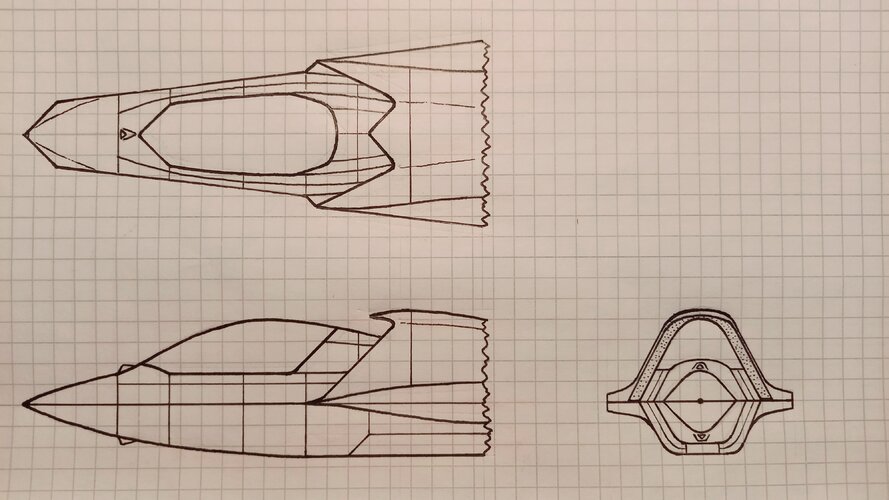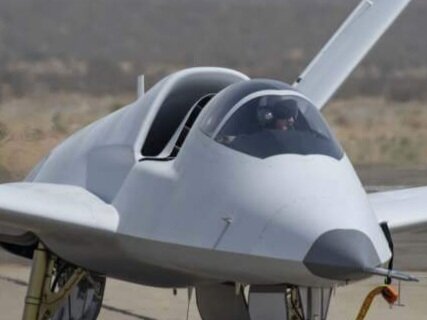,
Last edited:
awesome render!
a related question.
So FAR-21 is a nice example of a light Gripen sized fighter stealth aircraft with internal bays, angled body, etc
however my question is.. is there a market for these kinds of light weight stealth aircraft?
awesome render!
a related question.
So FAR-21 is a nice example of a light Gripen sized fighter stealth aircraft with internal bays, angled body, etc
however my question is.. is there a market for these kinds of light weight stealth aircraft?
You might have already addressed this question VTOLicious and if so I apologise, but does your design facilitate addition external hardpoints for overload configuration - i.e. after air-superiority is achieved and stealth isn't so much of a factor, additional air-to-ground weapons can be hung from these external hardpoint....?
Regards
Pioneer
Jim Smith said:As technology is continuing to evolve, lighter-weight fighters are making a come-back, as aircraft like the Gripen and Tejas are demonstrating that highly integrated systems with long-range missiles and highly effective sensors can now be packaged into a single-engined and single-seat airframe.

Peter Hultqvist said:When it comes to the Air Force the current fighter JAS 39 C/D will be maintained, as the new fighter JAS 39 E is integrated into the squadrons and becomes operational. This allows the Air Force to keep six fighter squadrons. The development of the next generation fighter aircraft will also commence.

I'd suggest two smaller, low tech F125-class engines for this theoretical design. Less height needed. Spread them out to disperse IR emissions. Flat nozzles with simple single-action paddles to provide instant positive pitch control. Shorter, less height for the tailerons and make them all-moving with sawtooth fit like on F-117A. Chisel-point, rather than pointed nose, and integrate the targeting sensors and laser designators into the shape. Leading outer tip of the intakes needs to move forward to improve intake geometry. You need a pronounced leading edge extension coming out of your main wing that blends into the top edge of the intake to improve angle of attack for literally no extra cost. Drop the seat by deepening the cockpit in relationship to the chine. Remove the single-piece windscreen and move towards high quality pin-hole cameras for general sight augmented with an AI-directed electro-optical bubble on each side of the fuselage to get zoom views. Bubble canopies were great for Mark 1 eyeballs before electronics surpassed the human eyeballs. Less glass overall, the better it will be to streamline the shape. Keep it a sliding canopy that seals up to the fuselage, but lifts up and slides back to open. Focus on flat, wider shaping for the fuselage. You need a proportionately large horizontal area in relationship to the vertical height for RAM to maximize the absorption of wave-form energy. You also want wingtips as far apart as practical to optimize the coordination of radar detectors to get passive, directional information.Thank you. I like the F-20 analogy.Superb work. A true son of the mighty F-20 Tigershark.
If you want it to more closely follow the area rule, you'll certainly have to replace the aft positioned ruddervator with a vertical (think M2K) or fill the gap b/w the wing trailing edge with a section increase of some sort.
In regards of area rule: Have a close look. It actually has a "hump" to fill the gap between wing an V-tail.
View attachment 672398
I'd suggest two smaller, low tech F125-class engines for this theoretical design. Less height needed. Spread them out to disperse IR emissions. Flat nozzles with simple single-action paddles to provide instant positive pitch control. Shorter, less height for the tailerons and make them all-moving with sawtooth fit like on F-117A. Chisel-point, rather than pointed nose, and integrate the targeting sensors and laser designators into the shape. Leading outer tip of the intakes needs to move forward to improve intake geometry. You need a pronounced leading edge extension coming out of your main wing that blends into the top edge of the intake to improve angle of attack for literally no extra cost. Drop the seat by deepening the cockpit in relationship to the chine. Remove the single-piece windscreen and move towards high quality pin-hole cameras for general sight augmented with an AI-directed electro-optical bubble on each side of the fuselage to get zoom views. Bubble canopies were great for Mark 1 eyeballs before electronics surpassed the human eyeballs. Less glass overall, the better it will be to streamline the shape. Keep it a sliding canopy that seals up to the fuselage, but lifts up and slides back to open. Focus on flat, wider shaping for the fuselage. You need a proportionately large horizontal area in relationship to the vertical height for RAM to maximize the absorption of wave-form energy. You also want wingtips as far apart as practical to optimize the coordination of radar detectors to get passive, directional information.Thank you. I like the F-20 analogy.Superb work. A true son of the mighty F-20 Tigershark.
If you want it to more closely follow the area rule, you'll certainly have to replace the aft positioned ruddervator with a vertical (think M2K) or fill the gap b/w the wing trailing edge with a section increase of some sort.
In regards of area rule: Have a close look. It actually has a "hump" to fill the gap between wing an V-tail.
View attachment 672398

I believe this design is relegated to a very light fighter role, play only supporting roles, and would require targets of opportunity versus any mainline roles. YourTWR is impossible to challenge much heavier fighters, so aim for low cost motors with adequate thrust to perform supporting roles. No need to put a giant matchstick that would be impossible to conceal IR emissions. At the same time, you don't need fancy thrust vectoring to steer you into supermanueverability, but flat paddles help reduce emissions and reinforce pitch command without moving control surfaces. Using two separate paddles in only one axis does allow some roll control, too, along the same reasons. You want to also have the smallest control surfaces, too, for keeping radar reflections lower. They would be much too small for adequate RAM on them to hide them from most reflections, so keep the size down as much as possible. Where you do have them, use zigzag surface boundaries where you cannot blend them, and use bending hinges like F-35 where you can to allow continuous RAM connections until they reach extreme movements. Everything is about the stealth.IMOHO, a joint effort will get a better result but they have to agree a mission first to fit the majority of roles. Do-able but tough. Easier after current events I think.
Emphasizing stealth limits your missions. But as a support fighter there is no reason it has no reason to exist. It can be a mule, to augment mainline fighters. You could offload standoff targeting information from external sources for them to release missiles and bombs. Preferably your aircraft has internal room for at least one 1,000-kg class weapon AND two 200-kg class weapons such as AIM-120. Anything external would mostly negate any stealth going for it. When not needing stealth you'd want one 1,000-kg class weapon and one 200-kg class load underneath each wing and the ability to carry extra fuel internally. Everything needs to be jettisoned by gas, no fancy trapezes.
Whatever choice you make, you probably want to limit the budget to <$40 million a plane. Having an AI pilot would be bonus, since no oxygen-generating equipment would limit you.
Excellent idea 2lb 22 inch compact low cost modular 3d printed honeycomb sandwich armoured structure/plating spread out equally over all vital areas plus 2 Giat 30 30mm cannons canard foreplanes to assist with shortening take off & landing distances and a rugged a-4 style undercarriage to operate from ice snow sand water areas mountains grass fields rocky cliffs rainforests roads highways volcanoes lava etcI'd suggest two smaller, low tech F125-class engines for this theoretical design. Less height needed. Spread them out to disperse IR emissions. Flat nozzles with simple single-action paddles to provide instant positive pitch control. Shorter, less height for the tailerons and make them all-moving with sawtooth fit like on F-117A. Chisel-point, rather than pointed nose, and integrate the targeting sensors and laser designators into the shape. Leading outer tip of the intakes needs to move forward to improve intake geometry. You need a pronounced leading edge extension coming out of your main wing that blends into the top edge of the intake to improve angle of attack for literally no extra cost. Drop the seat by deepening the cockpit in relationship to the chine. Remove the single-piece windscreen and move towards high quality pin-hole cameras for general sight augmented with an AI-directed electro-optical bubble on each side of the fuselage to get zoom views. Bubble canopies were great for Mark 1 eyeballs before electronics surpassed the human eyeballs. Less glass overall, the better it will be to streamline the shape. Keep it a sliding canopy that seals up to the fuselage, but lifts up and slides back to open. Focus on flat, wider shaping for the fuselage. You need a proportionately large horizontal area in relationship to the vertical height for RAM to maximize the absorption of wave-form energy. You also want wingtips as far apart as practical to optimize the coordination of radar detectors to get passive, directional information.Thank you. I like the F-20 analogy.Superb work. A true son of the mighty F-20 Tigershark.
If you want it to more closely follow the area rule, you'll certainly have to replace the aft positioned ruddervator with a vertical (think M2K) or fill the gap b/w the wing trailing edge with a section increase of some sort.
In regards of area rule: Have a close look. It actually has a "hump" to fill the gap between wing an V-tail.
View attachment 672398
What sort of gibberish is this?undercarriage to operate from ice snow sand water areas mountains grass fields rocky cliffs rainforests roads highways volcanoes lava etc
My most sincere apologies I’m just trying to keep any topics from year ago alive & not forgotten. My reasons are@Fighterreaper97 you are sailing close to being banned from posting. I suggest you read more and post less for a while rather than spamming multiple topics with semi-coherent posts on what is clearly a specific 'hobbyhorse' of yours.
I’m inspired via Pierre Sprey & Blacktail Defense with stamping the hypocritical bureaucracy that is the believe that bombing houses bridges roads railways factories ports & people would win wars when those people explain the truth that it was Russia that caused hitler to lose the war & not allied bombing like so many people believe & also it was Russias on Japan that caused japan to surrender & not little boy & fat man being dropped on Hiroshima & Nagasaki in ww2
what if rather one large bay for a light fighter
what about two smaller ones like on UCAVs?
what if rather one large bay for a light fighter
what about two smaller ones like on UCAVs?

Structurally, that looks much simpler and lighter than the - failed - Grumman A-12 Avenger II. The nose-wheel bay is far enough forward and the main-wheel bays plus bomb-bays are far enough aft that you can route a forward spar straight across to transfer loads between the wing leading edges. Straight load paths equal simpler and lighter structures.

You have not been ignored. You actually started the discussion I'm referring to in my post aboveI did suggest such a thing but was ignored which, my not being a designer, is a fair point.
Indeed, I almost forgot about 401. Thx for the hint!When you look at Model 401 it has a significant splitter, or on X-47A then they seem to add internal fences as they must have had issues.
Not impossible, just more complex to integrate than having an intake further back that is more isolated from the forebody

Either... or...
...Being whimsical, could you fit something within the "area rule bump"?
Haha, I'm already exploring the option to fit a single IRIS-T in the bump above the engine. The last resort so to say, just for self defence.
It basically fits, I just need to expand the bump a little bit more. However, the biggest concern is access to the bay for loading it.
I thought to make use of a "trapeze launcher" that pivots towards the rear, so that the missile can be slid onto the launch rail from the rear end. But I need to figure that out in detail.
I'll post some pics soon
Edit: F-22's "trapeze launcher" added:
View attachment 673517
She's alone and that's why she's sad. Besides, she can hardly see the target
That is very creative indeed. Have you also thought about how it will be mounted by the ground crew?Either... or...
...Being whimsical, could you fit something within the "area rule bump"?
Haha, I'm already exploring the option to fit a single IRIS-T in the bump above the engine. The last resort so to say, just for self defence.
It basically fits, I just need to expand the bump a little bit more. However, the biggest concern is access to the bay for loading it.
I thought to make use of a "trapeze launcher" that pivots towards the rear, so that the missile can be slid onto the launch rail from the rear end. But I need to figure that out in detail.
I'll post some pics soon
Edit: F-22's "trapeze launcher" added:
View attachment 673517
I finally found some time to explore the option of fitting a single IRIS-T into the "area rule bump". I´m quite happy with the result...
She's alone and that's why she's sad. Besides, she can hardly see the targetThat is very creative indeed. Have you also thought about how it will be mounted by the ground crew?Either... or...
...Being whimsical, could you fit something within the "area rule bump"?
Haha, I'm already exploring the option to fit a single IRIS-T in the bump above the engine. The last resort so to say, just for self defence.
It basically fits, I just need to expand the bump a little bit more. However, the biggest concern is access to the bay for loading it.
I thought to make use of a "trapeze launcher" that pivots towards the rear, so that the missile can be slid onto the launch rail from the rear end. But I need to figure that out in detail.
I'll post some pics soon
Edit: F-22's "trapeze launcher" added:
View attachment 673517
I finally found some time to explore the option of fitting a single IRIS-T into the "area rule bump". I´m quite happy with the result...
It seams to you you will need to design a special equipment just for that 1 job
